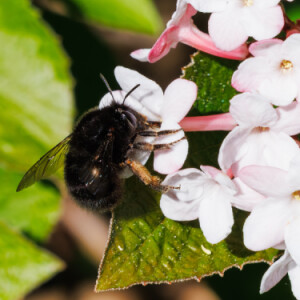Multitasking
I was impressed with the casual way this Hairy-footed Flower Bee used his front feet to clean some of the pollen from his proboscis as he flew from one aubretia flower to another. I sometimes eat while on the move, and back in my days of commuting it wasn't completely unknown for me to finish getting ready for work by applying slap during the morning train journey, but I think I might find the combination of washing and eating while travelling a bit problematic - especially as we have an overhead power shower. But maybe if I had six legs and four wings I'd give it a go.
We're at peak Plumpie now, with as many females flying as males. I try not to be sad at the thought that the earliest emerging males might have died already, but it's over a month since I spotted the first one, and you wouldn't really expect them to live much longer than that, even in the relatively benign weather conditions we've had here lately. This individual has been around long enough for the bright ginger hair with which he emerged to have faded to buff and grey, but he was very active today, and when he finally came to rest I could see that his wings were still in good condition, so I hope that he'll be around for a while yet.
By contrast, the female in my second photo appears to be very fresh. She was feeding from the newly opened blossom of a Viburnum juddii, but wasn't foraging for pollen - you can see that her orange pollen brush is clean, which suggests that she isn't yet constructing and provisioning a nest. She was followed around the shrub by a male, who jumped her a couple of times in an attempt to initiate copulation, but she shook him off and eventually he went away. Whether this means that she's not yet ready to mate, or has already mated but isn't yet ready to start laying her eggs, I have no way of knowing.
The females of some solitary bee species, such as the Ivy Bee (Colletes hederae), are mated as soon as, or even before they leave the nest, after which their smell changes and they're largely left alone by other males. In some other species such as the Red Mason Bee (Osmia bicornis), there's quite an elaborate courtship ritual, and during copulation the successful male coats his partner with a chemical which is believed to deter other males from approaching her. But the Hairy-footed Flower Bee doesn't seem to have any known mating rituals. According to my own observations very fresh females attract no attention from males, but from then on they can expect to be pounced on by males multiple times a day, whether or not they're engaged in nest building, for as long as the males keep flying. These attempts at copulation are almost always rejected (I've only ever seen one succeed), but the males persist: when the continuation of his DNA is at stake, you can't blame a boy for trying.


Comments
Sign in or get an account to comment.


